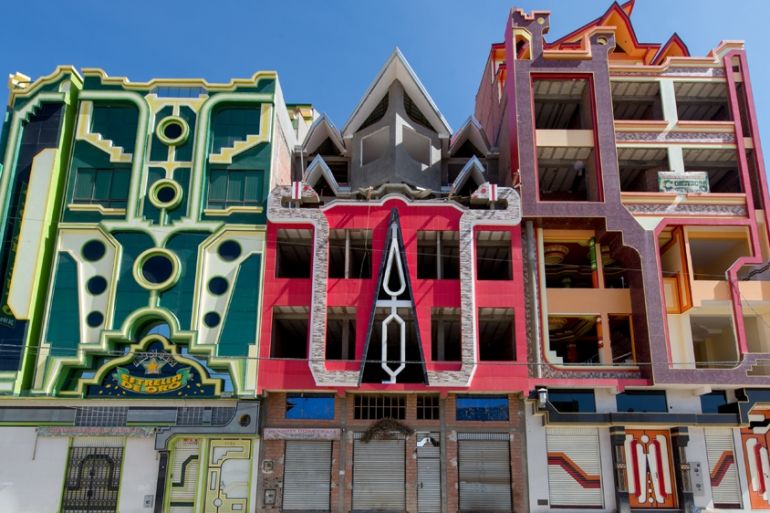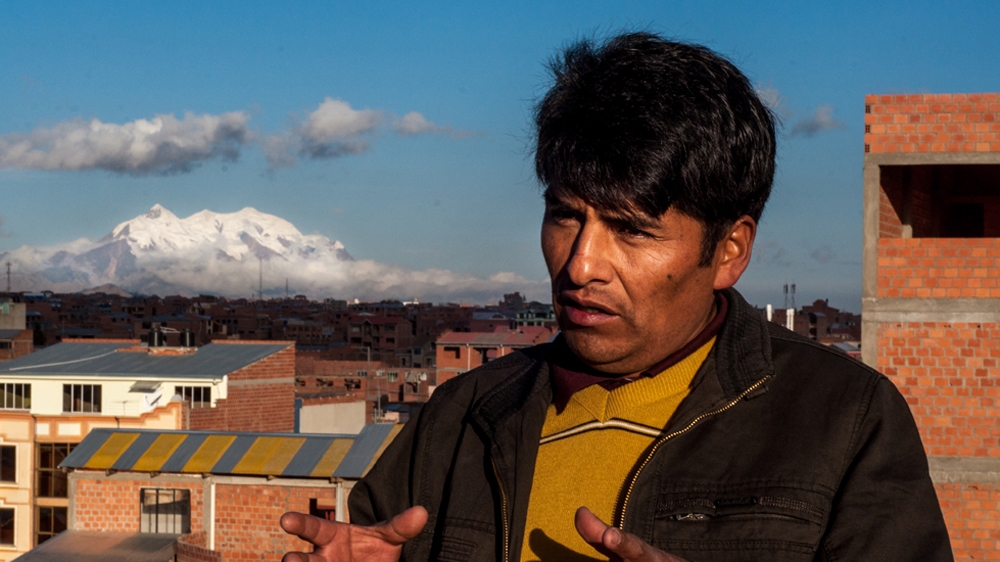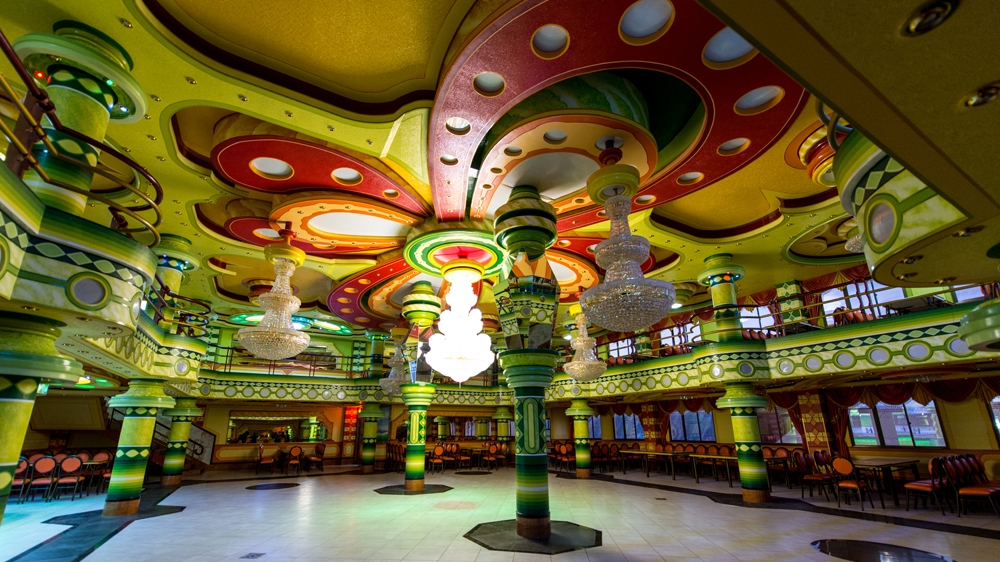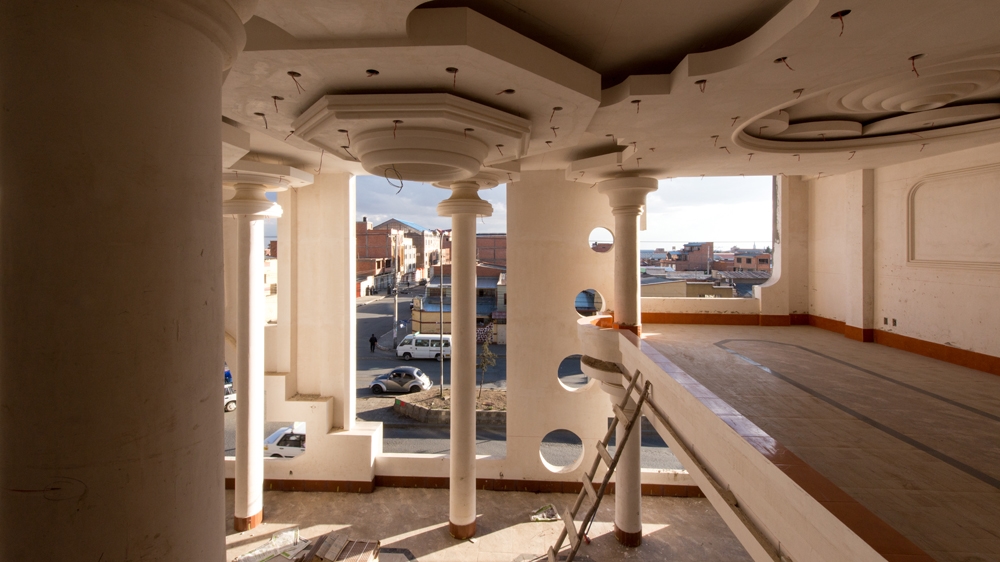How indigenous wealth is changing Bolivian architecture
A rising indigenous class is putting its money where its homes are and inspiring a new style of architecture.

El Alto, Bolivia – From the fifth floor of El Alto’s tallest building, the city looks like a flat red carpet, with thousands of low brick houses lining up towards the horizon.
Originally an indigenous slum built at 4,000 metres above sea level on the outskirts of La Paz, the country’s administrative capital, El Alto has swollen over recent years as people have migrated from rural areas. The change is evident in its panorama, as unusual buildings have started to pierce the otherwise even red expanse.
Keep reading
list of 4 itemsUS returns ancient artefacts looted from Cambodia, Indonesia
Mandela’s world: A photographic retrospective of apartheid South Africa
Portrait by Gustav Klimt sells for $32m at Vienna auction
“In 30 years, La Paz will become a suburb of El Alto,” Freddy Mamani, 43, tells Al Jazeera as he observes the city’s skyline.
Mamani is the architect behind many of these new “chalets”, which with their irregular forms and playful windows stand out from their earth-coloured surroundings. “I want to give this city an identity,” he says, “like an eternal exposition.”
He quotes the local Aymara indigenous culture as his main source of inspiration: the circles, the Andean cross and the designs reminiscent of butterflies, snakes and frogs featured on the facades are taken from the ponchos usually worn in the High Andean plateau region.
“The Aymara culture has finally reclaimed its role in this country,” he says.
 |
| From the top of one of his buildings, architect Freddy Mamani envisions how his work is going to turn this former slum into one of the most important places in Bolivia [Javier Sauras/Al Jazeera] |
Indigenous entrepreneurs
The city of El Alto broke suddenly on to the national political landscape in 2003, when labour unions and indigenous groups mounted strikes and road blocks against the government of Gonzalo Sanchez de Lozada, who they accused of selling off natural gas reserves to foreign countries and multinational companies.
Some 74 people died during what was later called the “Bolivian gas conflict”. Most were from El Alto. Since then, the city has become Evo Morales’ electoral stronghold, but also home to a rising middle class of enriched indigenous entrepreneurs.
“El Alto is a dry port,” says Mamani. “Products from abroad are being shipped here – pottery, textiles, aluminium and even minerals.”
Several of his recent clients are people from a rural background who have become successful traders over the past few years.
![A typical 'chalet' consists of a ground floor featuring a covered car park, a second floor with a grand ballroom, an upper floor with apartments and a roof with a replica of a traditional El Alto brick house [Javier Sauras/Al Jazeera]](/wp-content/uploads/2016/02/c8674ddd86224737a77ca81bca78251d_18.jpeg)
A booming economy
Since Evo Morales was elected as Bolivia’s first indigenous president in 2005, the economy has boomed and, over the past decade, extreme poverty – those living below the international poverty line of $1.25 a day – has been reduced by more than a third. According to the 2006 and 2012 census of the United Nations, about 1.2 million Bolivians have become middle class.
Many of these people are indigenous, and some are now so affluent that they can afford to build their own home or “chalet”.
A typical “chalet” consists of a ground floor with a covered car park, a second floor with a grand ballroom, an upper floor with apartments and a roof with a replica of a traditional El Alto brick house.
At the Prince Alexander, one of Mamani’s most spectacular works, the leftovers of last Saturday night’s party are being cleaned up under the glare of a two-metre-long chandelier that features 120 LED bulbs.
Among the abandoned wedding decorations and empty wine bottles, Alessandro Chino, 54, talks proudly of his investment.
“I am an entrepreneur, for me the ballroom is one more revenue,” he says. “So I rent this hall out for events like weddings, baptisms, graduations and official ceremonies.”
Four hundred people can fit on the dancefloor and hosting a graduation party in there at the weekend can cost 7,000 bolivianos (around $1,000). That is a third of the average annual income of a Bolivian citizen, according to the World Bank.

With the Prince Alexander, Mamani has surpassed himself. It has two ballrooms and an indoor football pitch.
“Freddy walked me around to see his previous works, but I asked him to build something different, something specific for me,” Chino says. “And I had to invest up to $800,000.”
He is a prime example of Bolivia’s rising indigenous class, having started out as a tailor at 14 before establishing his own brand of traditional clothing and trading textiles from Chile and Peru.
On average, customers pay $250,000 for the planning and building of a chalet, but material costs are extra.
“Many want marble, ceramics or precious stones. Of course that is more expansive,” Mamani says, smiling mischeviously. The most expensive house he has worked on so far cost $2m.
“I think it’s part of the Aymara culture,” he says. “We like to show our jewels, our diamonds.”
But his work has proved divisive.
“I’m happy because our region stands out, but it’s not related to our ancestral traditions,” says Juan, 25, who serves as a Mallku, an indigenous community leader, in the nearby city of Viacha, and is in El Alto for a meeting. “It’s something that has been imported from abroad,” he adds.
Other architects have also been critical, accusing Mamani of fabricating the idea that his designs continue the legacy of Aymara culture.
In a fiery column in El Deber newspaper, Rim Safar, the president of the Bolivian College of Architects, wrote: “This style is just the representation of a new economic and political elite.”
Many call his buildings “cholets” – mixing the words “chalets” and “cholo”, a racist term sometimes used for indigenous people.

‘The millionaire mindset’
But neighbours seems to be more worried about the parties hosted in these “chalets” than their architecture.
“They are nice, but they bring too many drunkards,” says Justino, 67.
Some are happy with the attention they have generated for the area. “I like them. I also saw that building on TV,” says Claris, 30, who runs a DVD shop 200 metres away from the Prince Alexander.
Nowadays, Freddy Mamani pays little attention to the critics. He built the first “chalet” back in 2005, and since then commissions have piled up. “So far I have built 60 houses of Andean architecture,” he says.
Considering his brightly coloured and extravagant designs, the sobriety of the architect’s home and office is surprising. There is no wall of glass, just four dusty Toyota pick-ups parked beside the entrance.
“In 20 years, half of the houses here will be built in my style,” says Mamani, as he sprawls out on a leather chair. On the bookshelf behind him are titles such as “The millionaire mindset” and “The building dictionary”.
He may be right. Despite the criticism, the style is becoming popular among other architects in different parts of the country.
“I prefer to call it Andean architecture,” he concludes. “I find the word ‘cholet’ derogatory.”
Follow Michele and Felix Lill on Twitter: @MikeBertelli, @FelixLill